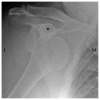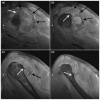Posterior dislocation of long head of biceps tendon following traumatic anterior shoulder dislocation: imaging and intra-operative findings
- PMID: 24421954
- PMCID: PMC3888182
- DOI: 10.3941/jrcr.v7i9.1516
Posterior dislocation of long head of biceps tendon following traumatic anterior shoulder dislocation: imaging and intra-operative findings
Abstract
A case of posterior dislocation of the long head of biceps tendon, a rare occurrence following traumatic anterior glenohumeral dislocation, along with complete rotator cuff rupture and large haemarthrosis is presented with imaging and intra-operative findings. The interposed tendon prevented complete reduction. Appearances at MRI were diagnostic and directed the surgical approach.
Keywords: MRI; Posterior dislocation long head biceps tendon; failed glenohumeral reduction; traumatic anterior glenohumeral dislocation.
Figures






Similar articles
-
Posterior dislocation of the long head biceps tendon: a case report, specific radiographic finding, and review of the literature.Skeletal Radiol. 2019 Jul;48(7):1131-1135. doi: 10.1007/s00256-018-3137-8. Epub 2019 Jan 5. Skeletal Radiol. 2019. PMID: 30612160 Review.
-
Anterior dislocation of the shoulder with rotator cuff injury and brachial plexus palsy: a case report.J Shoulder Elbow Surg. 2004 May-Jun;13(3):362-3. doi: 10.1016/j.jse.2003.12.011. J Shoulder Elbow Surg. 2004. PMID: 15111910 No abstract available.
-
Irreducible anterior dislocation of the shoulder due to soft tissue interposition of subscapularis tendon.Skeletal Radiol. 2008 Jan;37(1):63-5. doi: 10.1007/s00256-007-0370-y. Epub 2007 Oct 3. Skeletal Radiol. 2008. PMID: 17912520
-
Pseudoparalysis of shoulder caused by glenohumeral interposition of rotator cuff tendon stumps: a rare complication of posterior shoulder dislocation.Skeletal Radiol. 2013 Jan;42(1):135-9. doi: 10.1007/s00256-012-1478-2. Epub 2012 Jul 11. Skeletal Radiol. 2013. PMID: 22782290
-
Missed locked posterior shoulder dislocation with a reverse Hill-Sachs lesion and subscapularis rupture.Am J Orthop (Belle Mead NJ). 2013 Dec;42(12):E121-4. Am J Orthop (Belle Mead NJ). 2013. PMID: 24471154 Review.
Cited by
-
Posterior dislocation of the long head biceps tendon: a case report, specific radiographic finding, and review of the literature.Skeletal Radiol. 2019 Jul;48(7):1131-1135. doi: 10.1007/s00256-018-3137-8. Epub 2019 Jan 5. Skeletal Radiol. 2019. PMID: 30612160 Review.
-
Open reduction and rotator cuff repair of irreducible traumatic shoulder dislocation with sleeve-avulsion and glenohumeral interposition of the cuff: a case report and review of the literature.JSES Rev Rep Tech. 2022 May 23;2(3):399-405. doi: 10.1016/j.xrrt.2022.04.011. eCollection 2022 Aug. JSES Rev Rep Tech. 2022. PMID: 37588855 Free PMC article. No abstract available.
-
Long head of biceps in proximal fractures of the humerus: an underestimated problem?Acta Biomed. 2020 May 30;91(4-S):69-78. doi: 10.23750/abm.v91i4-S.9634. Acta Biomed. 2020. PMID: 32555078 Free PMC article. Review.
-
A massive rotator cuff tear in association with a posterior dislocation of the long head biceps tendon: a review of the literature on posterior long head biceps tendon dislocation.Skeletal Radiol. 2025 Jun 9. doi: 10.1007/s00256-025-04970-x. Online ahead of print. Skeletal Radiol. 2025. PMID: 40490587
-
Posterolateral dislocation and incarceration of the long head of the biceps tendon: a rare cause of irreducible anterior glenohumeral joint dislocation-a case report and brief review of the literature.Skeletal Radiol. 2024 Jun;53(6):1201-1204. doi: 10.1007/s00256-023-04468-4. Epub 2023 Oct 13. Skeletal Radiol. 2024. PMID: 37828097 Review.
References
-
- Nakata W, Katou S, Fujita A, Nakata M, Lefor AT, Sugimoto H. Biceps pulley: normal anatomy and associated lesions at MR arthrography. Radiographics. 2011;31:791–810. - PubMed
-
- Lee JC, Guy S, Connell D, Saifuddin A, Lambert S. MRI of the rotator interval of the shoulder. Clin Radiol. 2007;62:416–423. - PubMed
-
- Berbig R, Weishaupt D, Prim J, Shahin O. Primary anterior shoulder dislocation and rotator cuff tears. J Shoulder Elbow Surg. 1999;8:220–225. - PubMed
-
- Robinson CM, Shur N, Sharpe T, Ray A, Murray IR. Injuries associated with traumatic anterior glenohumeral dislocations. J Bone Joint Surg Am. 2012;94:18–26. - PubMed
-
- Bauer T, Vuillemin A, Hardy P, Rousselin B. Posterior dislocation of the long head of the biceps tendon: a case report. J Shoulder Elbow Surg. 2005;14:557–558. - PubMed
Publication types
MeSH terms
LinkOut - more resources
Full Text Sources
Other Literature Sources
Medical

